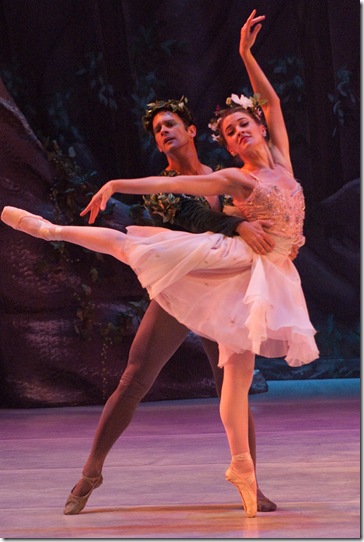Over the years I’ve seen a number of ballet companies that feature a large contingent of children, and usually that means there’s a good deal of wiggle room for the kids in the presentation, which allows things to be not-so-precise but irresistibly crowd-pleasing.
But Colleen Smith’s company, the Florida Classical Ballet Theatre, doesn’t do things that way. In a Wednesday afternoon performance at the Eissey Campus Theatre in Palm Beach Gardens, the troupe – including all its younger and older members – demonstrated a thorough, deep discipline that let viewers take in the broader visual aspects of its work: precisely designed, colorful costumes, plenty of movement without mania, and smart bits of stage business with simple props such as old-fashioned beach parasols.
The FCBT also showed that it’s possible to create a thoroughly entertaining afternoon of traditional dance with relatively modest means if your dancers are talented enough and your choreographic planning is carefully thought out. Which they are, and which it was.
The major work on the program was A Midsummer Night’s Dream, which Smith patterned after Sir Frederick Ashton’s The Dream, but the afternoon opened with two original ballets, the first of which was From Head to Toe, a six-person interpretation of Eric Carle’s 1997 book by that name for toddlers. Set to three movements from Shostakovich’s Jazz Suite No. 2, Smith’s ballet played two principals – Lily Ojea and Marshall Levin – against four supporting women, all of the dancers dressed in late 19th-century on-the-town style.
Carle’s book is about motion, and getting its readers to imitate the actions of the animals within, such as a gorilla thumping its chest. Smith translated the actions in the book into the ballet, but it wasn’t noticeable in a didactic way: at one point, the four women did a kind of shoulder and body shimmy, and at the end, they lay down on the floor and wiggled their feet, as Carle calls for in his final pages. But it was the total effect of this slight but well-crafted piece of dance that was most memorable, with its green-and-pink color scheme, its carefully calibrated movements, and its sense of smart fun.
The second original ballet, Tidbits and Doodles, is unfortunately named for such an expertly designed piece, one that could profitably be exported to other youthful classical companies (maybe it needs a punny name, something like Taking It Littorally). It’s a 1920s-era beach scenario choreographed by Smith and the dancers to ballet sketches by Mozart (K. 299c), and it was nothing short of delightful. Three tiers of dancers in different age groups from teens down to elementary school moved in and out like cheerful platoons, with the older girls making good use of white parasols, opening and shutting them quickly at one point as they exited the stage.
There were all the clichés of the boardwalk of a distant day, such as striped cabanas, bodybuilders (a funny Eric Emerson), multiple beachballs, and seaside hucksters, such as in the main event of the dance, which had to do with a showman (Levin) offering $1 views of a live mermaid (Ojea), to the gullible astonishment of the crowd. Like From Head to Toe, this ballet also had lots of fourth-wall shattering as dancers routinely engaged the audience with direct looks, especially here, when the whole company offered a collective mouths-agape as they discovered that the mermaid and her handler had slithered away.
And as in the first ballet, Tidbits featured a constant variety of dance steps as groups of performers moved in and out of the scene; you noticed the pliés and en pointes, but they came across as natural, not fussy, and in the service of a general style of movement across the stage that was busy without being hyperkinetic or aggressive. It all flowed like the water near the imaginary shore, testament to how the formal language of ballet can bring a sense of grace and control to what in several cases here had to be ideas generated by youthful dancers who didn’t want to stand still.
After intermission came A Midsummer Night’s Dream, which like Ashton’s version focused on the forest magic of Shakespeare’s play. Ensemble work here from fairies to rustics was uniformly good, and there was fine dancing from the lovers’ couples – Jared Jacoby and Jessica Haley as Lysander and Hermia, Ben Slayen and Cassie Robinson as Demetrius and Helena – and from Levin as Bottom, who offered charming business while wearing his donkey head, scratching his back on a tree and munching food from an outstretched hand.
Katherine Davis made an excellent Puck, nimble and light-footed as she could be, perfectly underlining the quicksilver nature of this character with athletic but delicate steps. Rogelio Corrales made a strong Oberon, and Ojea a splendid Titania, especially in the climactic pas de deux to the celebrated Nocturne from Mendelssohn’s popular score. Ojea ended the duet with three perfect, elegant splits, a coda of sheer loveliness to the one major moment of old-fashioned balletic high style on the program.
